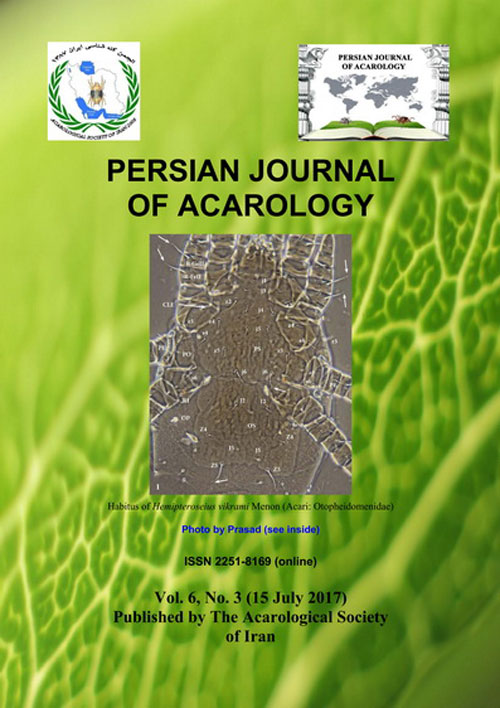فهرست مطالب

Persian Journal of Acarology
Volume:6 Issue: 3, Summer 2017
- تاریخ انتشار: 1396/05/16
- تعداد عناوین: 7
-
-
Page 143Hemipteroseius vikrami Menon, 2011 (Acari: Otopheidomenidae: Treatinae) has been considered a junior synonym of Hemipteroseius indicus (Krantz & Khot, 1962). Both species were described from India from the red cotton bugs Dysdercus koenigii (F.) and Dysdercus cingulatus (F.), the latter is widely distributed in India and some other countries. The sigilla of the podonotum and opisthonotum are also described for the first time in this mite.Keywords: Otopheidomenidae, Pyrrhocoridae, red cotton bugs, sigilla, Treatiinae
-
Page 161Nothrotrombidium birjandensis sp. nov. (Acari: Trombidiformes: Trombellidae) collected from forest soils (off host) in Hotel Kouhestan region, Birjand city, Khorasan Jonoobi province (South Khorasan province), Iran, is described and illustrated. This is the third larval species of Nothrotrombidium which is described in the world. A key to world larval species of Nothrotrombidium is provided.Keywords: Acrididae, Birjand, ectoparasite, Noctuidae, terrestrial Parasitengona
-
Page 173Cicaditrombium lorestanensis Noei sp. nov. (Acari: Trombidiformes: Trombidiidae) collected from forest soils (off host) in Hotel Kouhestan region, Birjand city, South Khorasan province, and also collected from soil samples (off host) from under an apple tree in the Bayranshahr city, Lorestan province, Iran, is described. This is the second larval species of Cicaditrombium which is described in the world.Keywords: Bayranshahr, Birjand, incertae sedis, Prostigmata, Trombidiformes, Trombidioidea
-
Page 183During survey for the pests of Buxus plants in Bandar Gaz, Golestan province, Iran, Eriophyes canestrinii (Nalepa, 1890) was collected on Buxus sempervirens hyrcana (Pojarkova) Tachtadzjan (Buxaceae) and recorded for the first time in Iran. High population of this mite species made damage on the host plant as buds and leaves deformation. Herein Iranian specimens of this mite species was presented and a key to the eriophyoid mite species collected on boxes worldwide and the information about their morphology, type host, type locality and habitus are provided.Keywords: Bud gall, Buxus, Damages, Eriophyidae, Pest
-
Page 193A new species of the genus Ledermuelleriopsis, L. aminiae sp. nov. is described and illustrated based on female and male specimens collected from soil under oak trees, Karchan region, Markazi province, Iran.Keywords: Description, mite, new taxon, predator, small arthropods
-
Page 203
The acaricidal activity of entomopathogenic fungus Beauveria bassiana (strain GHA), three essential plant oils namely, neem (Azadirachta indica A. Juss), mahogany (Swietenia mahogoni L.) and karanja (Millettia pinnata L.), and two insect growth regulators (buprofezin and lufenuron) were evaluated against the two-spotted spider mite, Tetranychus urticae Koch under laboratory conditions by leaf disc bioassay method. Results revealed that B. bassiana was highly effective in controlling T. urticae adults causing mortality from 3 days after treatment application. Among the plant oils tested, karanja and mahogany oils were found most effective against T. urticae and both the oils showed significantly better performance compared to all other treatments (P
Keywords: Beauveria bassiana, bioassay, essential plant oils, insect growth regulators, Tetranychus urticae -
Page 213This study was conducted to investigate the infestation of Zebu cattle by ixodid ticks in Maiduguri, Northeastern Nigeria. A total of 500 cattle were examined and adult ticks were collected from five different body parts for morphological identification. Our results indicate that 59.8% of cattle were infested with ixodid ticks and the differences in prevalence of tick infestation between study sites, breeds and management systems were significant (pKeywords: Amblyomma variegatum, body parts, Hyalomma truncatum, Nigeria, prevalence, Rhipicephalus sanguineus s.l

